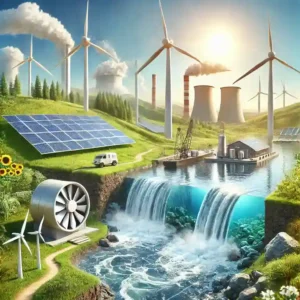Intensity levels of a thunderstorm
Thunderstorms, a spectacle of nature that combines majesty and power, can vary significantly in intensity. From distant lightning that lights up the night sky to severe storms that threaten to knock out power, it's essential to know their intensity levels and how to prepare for them.
In this article, we will not only explore the science behind these natural phenomena, but we will also highlight the importance of having reliable energy solutions to face any eventuality.
Table of Contents
What is a thunderstorm?
An electrical storm, also known as a shower or cloudburst, is a meteorological phenomenon characterized by the presence of lightning and its acoustic effect on the Earth's atmosphere, thunder. These electrical phenomena are produced by the discharge of electricity accumulated in storm clouds, known as cumulonimbus clouds.
Main components
Thunderstorms are not just lightning and thunder. They are also often accompanied by heavy rain, gusts of wind, hail and even, in more extreme situations, they can give rise to tornadoes.
However, lightning is the most distinctive and dangerous component of a thunderstorm. These electrical discharges can reach temperatures five times higher than the surface of the sun and travel at dizzying speeds, impacting the ground in milliseconds.
Origin of your energy
The driving force behind every thunderstorm is energy. This energy originates from the uneven heating of the Earth. As warm, moist air rises, it encounters cooler air in the upper layers of the atmosphere. This thermal shock creates instability, leading to the formation of storm clouds and eventually the release of electricity in the form of lightning.
Thunderstorm intensity classification
Thunderstorms, while they share common characteristics, are not all the same. Depending on their intensity and associated phenomena, they can be classified into different categories, ranging from light events to potentially destructive storms.
Light thunderstorms
They are the most common and are usually short-lived. Although lightning and thunder occur, the amount of precipitation is minimal. These storms generally do not present a great danger, but it is always advisable not to expose yourself openly to lightning.
Moderate thunderstorms
These storms are more intense than light storms and can be accompanied by heavier rain and gusts of wind. Small hail is possible. Electrical activity is more intense, and it is vital to seek shelter when a storm of this nature approaches.
Severe thunderstorms
They are the most intense and dangerous. They are accompanied by torrential rains, strong winds, and large hail. In these storms, there is a risk of flash flooding, falling trees, and damage to infrastructure. In addition, electrical activity is very intense, with frequent lightning and powerful thunder. It is essential to follow the recommendations of the authorities and seek refuge in a safe place.
Determinants of intensity
Several factors determine the intensity of a thunderstorm, including the level of atmospheric instability, the amount of moisture in the air, and the presence of frontal systems or topographic conditions that favor the rapid rise of warm, moist air.
Impact and risks depending on the intensity of the electrical storm
Thunderstorms, depending on their intensity, can have a variety of impacts on our lives and the environment around us. From simple annoyances to devastating consequences, it is essential to understand and anticipate the associated risks.
Impact of light thunderstorms
- Momentary interruptions: These storms can cause brief power outages or interruptions in communication services.
- Discomfort in outdoor activities: Although they are not extremely dangerous, it is advisable to take shelter at the first sign of lightning.
Impact of moderate thunderstorms
- Minor flooding: Heavier rains can cause flooding in low-lying areas or areas with insufficient drainage.
- Falling branches and small objects: Moderate winds can knock down tree branches or displace unsecured objects.
- Extended outages: Electrical service and communications may be affected for a longer period of time.
Impact of severe thunderstorms
- Major and flash flooding: Heavy rainfall can cause devastating flooding, especially in urban areas or areas with rivers and streams.
- Damage to infrastructure: Wind and hail can damage buildings, vehicles, crops and other structures.
- Risk of injury or death: Lightning, falling trees, and hail represent a direct danger to people.
- Prolonged power outages: Severe thunderstorms can cause significant damage to electrical infrastructure, resulting in power outages that can last for hours or even days.
Are you finding this information useful?
We know how crucial it is to be well informed, especially when it comes to natural phenomena as impactful as thunderstorms. If you find this content valuable and want to learn more about how to protect yourself and guarantee the continuity of your activities in the event of any eventuality, we invite you to explore our Blog.
There, you will find more articles, tips and solutions related to the world of electrical generators and protection against adverse weather events.

Electric generators in the face of power outages
Thunderstorms, regardless of their intensity, can cause interruptions in the electrical supply, generating not only discomfort but also potential risks and losses. In these cases, having an alternative energy source becomes crucial.
The importance of continuous energy
In our modern society, we rely heavily on electricity for almost everything: lighting, cooling, heating, communications, and more. A prolonged outage can:
- Damaging foods stored in refrigerators and freezers.
- Disrupt communication and security systems.
- Paralyze essential businesses and operations.
- Increase risks in hospitals and health centers if they do not have support.
Electric generators as a solution
Electric generators are presented as the ideal solution to face power outages. These devices convert mechanical energy into electrical energy, ensuring a continuous supply of electricity.
- Diesel emergency generator: At JRH Power Generator we offer diesel generators, recognized for their durability and efficiency, ideal for long hours of operation.
- Three-phase diesel generators: Designed for industries or places that require a large amount of energy, these generators ensure optimal performance and balanced distribution of electricity.
Preparations for a thunderstorm
Anticipation is key. If you live or work in an area prone to thunderstorms:
- Consider installing an electric generator suitable for your needs.
- Perform periodic maintenance on the generator to ensure its optimal operation.
- Make sure you have enough fuel for the generator.
- Familiarize yourself with its operation and follow the safety recommendations.
Do you need advice?
Facing inclement weather, especially thunderstorms, can raise a lot of doubts. Is my home or business properly protected? How can I ensure continuity of power during and after the storm?
In JRH Power Generator, we understand your concerns and we are here to help you. Our experts can guide you in selecting the electric generator that best suits your needs, ensuring that you never run out of power, regardless of the intensity of the thunderstorm.

En el mundo moderno, donde la electricidad es fundamental para nuestras actividades diarias, las interrupciones eléctricas son un gran inconveniente, pueden afectar nuestra productividad y

Las turbinas eólicas se han convertido en el emblema de la energía renovable, ofreciendo una solución sostenible y limpia frente a los combustibles fósiles. Sin

Cuando se trata de mantener la energía en situaciones de emergencia, durante viajes de campamento o en eventos al aire libre, un generador de 3500

En tiempos de cortes de energía o desastres naturales, saber cómo usar un generador para alimentar una casa puede marcar la diferencia entre estar preparado

La búsqueda de energías alternativas se ha convertido en un pilar fundamental en la discusión sobre sostenibilidad y el futuro energético del planeta. Pero, ¿cuáles

En un mundo donde la demanda de energía eléctrica sigue en aumento, las interrupciones de servicio y el costo creciente de la electricidad han impulsado

